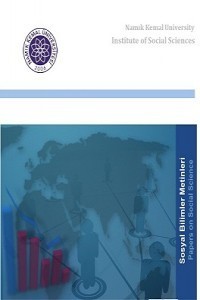Comparison of the Economical Indicators of Turkey and European Union States via Decision Tree Method
European Union, Data Mining, Decision Trees, C4.5 Algorithm, J48 Algorithm
___
- Berson, A., Smith S. & Thearling, K. (1999). Building Data Mining Applications for CRM. McGraw-Hill Companies. Doğan, N. & Özdamar, K. (2003). Chaid Analizi ve Aile Planlaması ile Bir Uygulama, T.Klin Journal of Medical Science. vol.23, No. 5, pp. 392-397. Dormen, D. (2003). Bankacılık Sektöründe Müşteri İlişki Yönetimi: CRM Acısından VM Yöntemi. Doctorate Thesis. Dunham, M.H. (2003). Data Mining Introductory and Advanced Topics. Southern Methodist University: Pearson Education Inc. Eker, H. (2006). Veri Madenciliği veya Bilgi Keşfi 1-2. http://www.ikademi.com/insan-kaynaklari-bilgi-sistemleri/621 Han, J. & Kamber, M. (2006). Data Mining: Concepts and Techniques. San Francisco: Morgan Kaufman Publishers. Hand, D., Mannila, H. & Smyth P. (2001). Principles of Data Mining. MIT Press Kabatepe, E., 2005. Müzakere Sürecinde AB ve Türkiye. Ankara: TURKAB. Kandartzic, M. (2003). Data Mining Concepts Models and Algorithms. John Wiley& Sons. Myatt, J.G. (2007). Making Sense of Data A Practical Guide to Exploratory Data Analysis and Data Mining. A John Wiley& Sons, Inc., Publication. Larose, T.D. (2005). Discovering Knowledge in Data An Introduction to Data Mining. A John Wiley& Sons, Inc., Publication Quinlan, J.R. (1993). C4.5 Programs For Machine Learning. California: Morgan Kaufman Publisher Seidman , C. (2001). Data Mining with Microsoft SQL Server 2000. Washington: Microsoft Press. Tan, P.N., Steinbach M. & Kumar, V. (2006). Introduction to Data Mining. Boston: Pearson Addison Wesley. Witten, I.H. & Frank, E. (2005). Data Mining Practical Machine Learning Tools and Techniques. Second Edition, Department of Computer Science University of Waikato: Morgan Kaufman Publisher
- ISSN: 1308–4453/1308–4895
- Yayın Aralığı: Yılda 2 Sayı
- Başlangıç: 2008
İlişki Katsayılarının Karşılaştırılması: Bir Simülasyon Çalışması
Dilek ALTAŞ, E. Çiğdem KASPAR, Özlem ERGÜT
Meksika, Baja California, Tijuana’da Süt Endüstrisinin SosyoEkolojik Özellikleri
O. Alberto POMBO, Lilia Betania VAZQUEZ GONZALEZ
Comparison of the Economical Indicators of Turkey and European Union States via Decision Tree Method
